Understanding the Price of a One Carat Diamond
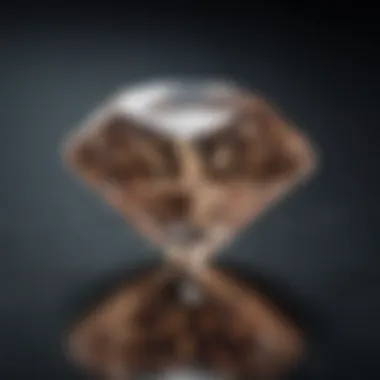

Intro
When you think of diamonds, images of breathtaking radiance and timeless elegance probably come to mind. Yet, the journey to understanding the average price of a one carat diamond is not as straightforward as one might think. This seemingly simple figure carries a multitude of implications, shaped by the interplay between market dynamics, individual preferences, and ethical considerations.
In this article, we will dissect the numerous factors contributing to diamond pricing, ensuring that you gain a well-rounded grasp of the nuances involved.
Gemstone Overview
Diamonds are not just shiny rocks; they're complex natural treasures that provoke deep appreciation and desire. To properly understand their pricing, it's critical to grasp what defines a diamond and how it fits into the broader category of gemstones.
Definition and characteristics
A diamond is a crystalline form of carbon that forms under intense heat and pressure within the earth's mantle. Known for their exceptional hardness and brilliance, diamonds are often characterized by the Four Cs: Cut, Color, Clarity, and Carat weight. Each aspect plays a crucial role in determining the quality and, consequently, the price of the diamond.
- Cut: Refers not only to the shape of the diamond (like round, princess, or emerald) but also its facets and how well it reflects light.
- Color: Typically ranges from colorless to shades of yellow or brown; colorless diamonds are usually the most valuable.
- Clarity: Concerns the presence of internal or external flaws known as inclusions and blemishes, respectively.
- Carat weight: Weight is measured in carats, and while larger diamonds are rarer, smaller diamonds can also shine brightly depending on their quality.
Classification of gemstones
Diamonds fall under the broader umbrella of gemstones, which can be grouped into precious and semi-precious categories. While diamonds, rubies, sapphires, and emeralds are considered precious, a myriad of other stones, including amethyst and garnet, fall into the semi-precious category. Each type of gemstone has unique characteristics, origins, and price points, all of which can skew perceptions of value.
"Understanding gemstone classification is vital for any potential buyer, enabling them to make informed decisions with both eye and mind."
Properties of Gemstones
Delving deeper, we find that the properties of gemstones can greatly influence their pricing. Understanding both the physical and chemical aspects can unveil the secrets behind their appeal.
Physical properties
The physical properties of a diamond include its hardness, luster, refractive index, and specific gravity. Diamonds score a perfect ten on the Mohs scale of mineral hardness, making them remarkably durable, perfect for both everyday wear and high-stakes situations. Their luster contributes to their visual appeal; the way light interacts with the surface creates that trademark sparkle.
Chemical properties
Chemically, diamonds are pure carbon, yet their formation process imbues them with unique features. Variations in the crystal structure, impurities, or even their growth environment can lead to different colors, such as blue or pink diamonds, often commanding staggering premiums at auction houses. Understanding these properties helps clarify why certain diamonds are priced as they are.
In summary, exploring the average price of a one carat diamond involves deciphering its intrinsic qualities, the broader category of gemstones, and the multidimensional factors that contribute to fluctuating market trends. Whether you're a collector or searching for the perfect engagement ring, knowledge is your golden ticket in the realm of diamonds.
Prelude to Diamond Pricing
When it comes to acquiring a diamond, knowing its price tends to be one of the first questions on anyone's mind. The intricacies of diamond pricing open a gateway to understanding not only the value of a one carat diamond but also the factors that shape this estimation. Grasping the fundamentals of how diamonds are priced is essential for both buyers and sellers alike.
The average price of a one carat diamond can fluctuate considerably based on multifaceted elements, making it imperative for consumers to navigate this often murky landscape with clarity. This exploration into diamond pricing does not just reveal numbers or market tendencies, but also uncovers insights into the gemstones themselves, including their characteristics and the market forces that influence their perceived value.
Understanding Carat Weight
Carat weight is often the most visible aspect taken into consideration during the diamond buying process. Simply put, the carat is a unit of measurement that indicates how heavy a diamond is. One carat equals 0.2 grams, but this measurement carries much more significance than just weight alone.
Many people equate larger carat weights with higher value; however, the reality is a tad more complex. A one carat diamond may come in various shapes and sizes, affecting its appearance and, in turn, its value. For instance, a one carat round diamond might look smaller or larger than a one carat princess cut diamond due to various factors including cut depth.
"Not all diamonds of the same weight are created equal; it’s vital to consider how the carat weight interacts with other characteristics."
Often, diamonds can be priced per carat, wherein smaller weights can be substantially cheaper than diamonds that just tip the scales at the next carat weight bracket. For this reason, a good understanding of carat weight and how it correlates with overall appearance and investment potential can significantly influence buying decisions.
The Significance of Diamond Quality
While carat weight may catch the eye, diamond quality is what tends to seal the deal. The quality of a diamond is generally assessed through the "Four Cs": Cut, Color, Clarity, and Carat. Each of these elements plays a pivotal role in determining what's tucked into a diamond's price tag.
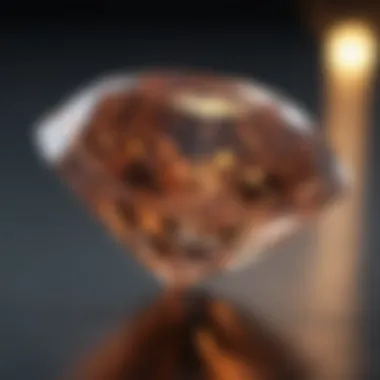
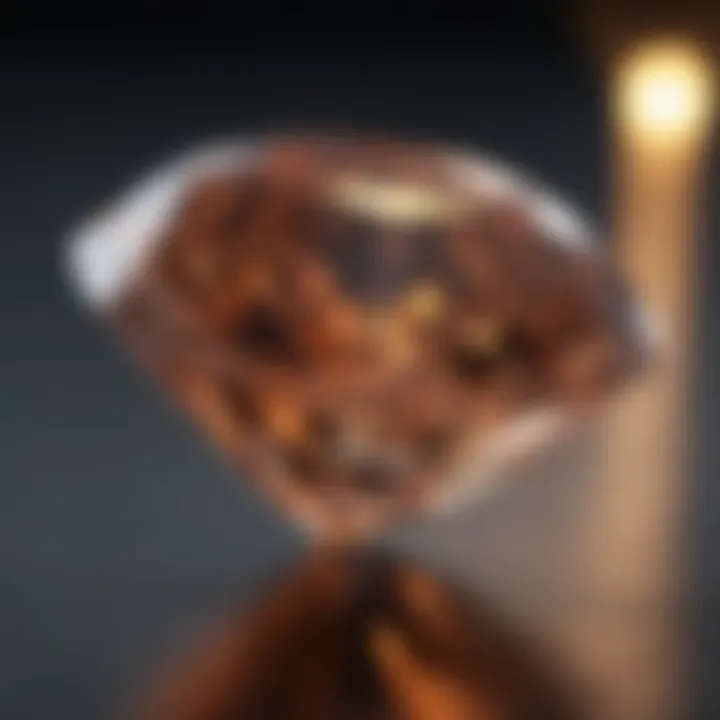
- Cut: The way a diamond has been shaped and polished can significantly impact its brilliance and sparkle. An expertly cut diamond can look more dazzling than a poorly cut one, even if they share similar carat weights.
- Color: Diamonds range in color from completely clear to various shades of yellow or brown. The less color a diamond has, the more valuable it generally is.
- Clarity: This refers to the presence of internal and external flaws. A flawlessly clear diamond will command a higher price than one with visible inclusions or blemishes.
Evaluating these quality factors is essential for anyone looking to invest in diamonds, as they help establish the true value of a stone beyond just its carat count. The nuances in quality can lead to significant price differential, reinforcing the notion that understanding diamond pricing goes much deeper than merely knowing the carat weight.
Factors Influencing Diamond Prices
Understanding the factors that influence diamond prices is essential for anyone looking to make an informed purchase. The diamond market is known for its complexity, with various elements intertwining to determine the value of this precious gem. When considering the average price for a one carat diamond, several key factors come into play that not only affect the cost but also the overall appeal and desirability of the stone
Importance of Understanding Factors
The pricing of diamonds isn't merely a case of supply and demand. It involves a harmonious blend of characteristics that include cut quality, color grading, clarity ratings, and the distinction between natural and synthetic diamonds. Each of these aspects plays a significant role in not just the price but also the overall aesthetics and durability of the diamond.
Gaining knowledge in these areas allows consumers and collectors to better navigate the market, avoid overpricing pitfalls, and ultimately select a diamond that meets their preferences and budget.
Cut Quality
The cut quality of a diamond is arguably one of the most crucial factors that can influence its price. It reflects how well the stone has been shaped, polished, and aligned. A well-cut diamond not only sparkles more but also refracts light in a way that can enhance its visual appeal.
When evaluating cut quality, different grading systems exist, with terms like "Excellent", "Very Good", and so forth. Essentially, the better the cut, the more the diamond will fetch in the market. Think of it as the difference between a perfectly cooked steak versus one that’s overdone; presentation matters!
Color Grading
Color grading determines how colorless a diamond appears. Diamonds are graded on a scale from D (colorless) to Z (light yellow or brown). The less color a diamond has, the more rare and expensive it usually is. Some buyers might not realize that even a small tint can substantially affect the price.
An effectively colorless diamond reflects the most light, leading to that sought-after brilliance. Buyers should be cautious of diamonds that appear nearly colorless, as sometimes, what seems like a small difference in hue can drastically alter its value.
Clarity Ratings
Clarity ratings examine the presence of internal or external flaws, known as inclusions and blemishes. A diamond with fewer imperfections generally commands a higher price. The clarity scale ranges from Flawless (no inclusions visible under 10x magnification) to Included (inclusions visible to the naked eye).
If you think of clarity as the skin quality of fruit, the more blemish-free it is, the more appealing and valuable it becomes. Buyers often overlook this aspect, but a higher clarity rating can significantly increase the overall beauty and, consequently, the price of the diamond.
Natural vs Synthetic Diamonds
The choice between natural and synthetic diamonds can fully change the dynamics of pricing. Natural diamonds are formed over millions of years under immense pressure and heat in the Earth’s mantle, while synthetic diamonds are created in labs, making them much cheaper but also often perceived as less unique.
Synthetic diamonds can be an appealing option for those looking to save money, but their value tends to depreciate faster because they lack the historical allure of their natural counterparts.
"In the world of diamonds, familiarity with cut, color, clarity, and origin can save you both headaches and dollars."
Current Market Trends
When it comes to grasping the nuances of diamond pricing, understanding current market trends is essential. The diamond market isn't static; it ebbs and flows in response to various elements, influencing prices substantially. Observing these trends can help potential buyers and sellers navigate the complicated landscape of diamond valuation.
Economic Factors
Economic conditions play a pivotal role in shaping the market for one carat diamonds. When the economy is booming, consumer confidence tends to rise, leading to increased spending on luxury items, including diamonds. Conversely, during a downturn, consumers often tighten their belts. Economic indicators such as GDP growth, employment rates, and inflation can give insights into the overall health of the economy and its impact on diamond demand.
"The connection between a thriving economy and diamond sales is as clear as day. When wallets are open, diamonds sparkle brighter."
Moreover, global economic stability affects the supply chain. For instance, disruptions in major diamond-producing regions can lead to shortages, causing prices to spike. On the flip side, too much supply without corresponding demand can result in price reductions. So, keeping an eye on economic indicators is crucial for anyone interested in the diamond trade.
Consumer Demand
The desire for diamonds has transformed, reflecting broader social and cultural shifts. One could almost say that consumer sentiment is the heartbeat of the diamond market. Currently, there's a noticeable trend towards personalization and uniqueness; buyers are increasingly drawn to distinct and custom designs rather than conventional choices. This shift implies that a one carat diamond's price may vary based not just on its intrinsic qualities but also on its design and the story behind it.
Additionally, millennials and Gen Z are emerging as substantial consumers in the diamond market, often prioritizing sustainability and ethical sourcing over traditional notions of luxury. As they pave the way for a new consumer landscape, their preferences influence what buyers look for and, subsequently, these dynamics affect pricing. Sellers of one carat diamonds, thus, must adapt by offering options that resonate with contemporary values.
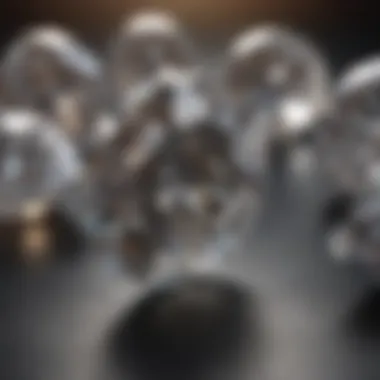
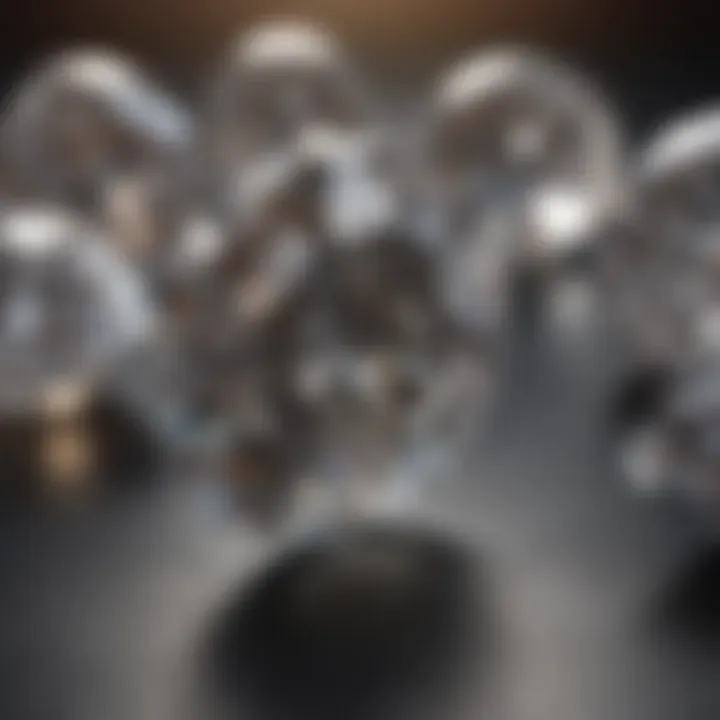
Seasonal Variations
Fads come and go, but some trends are undeniably cyclical. The diamond market is no exception. Seasonal variations can significantly affect demand and price. For example, four key times of the year are typically more active for diamond sales: Valentine's Day, engagements around Christmas, the bridal season in spring, and anniversaries throughout the summer months. During these periods, demand tends to spike, often leading to higher prices for one carat diamonds.
On the other hand, during the off-season, sellers may offer promotions or discounts to stimulate interest, which can lower prices. It’s wise for buyers to be aware of these fluctuations, as purchasing during off-peak times can lead to significant savings.
Average Price Analysis
When it comes to purchasing a one carat diamond, understanding its average price is paramount. This segment delves deep into the nuances of diamond pricing, shedding light on how various factors shape the market. With knowledge of price histories, regional variations, and comparisons with other gemstones, potential buyers can make informed choices. Such analysis does not merely enhance purchasing power; it enriches the overall experience of owning and appreciating these exquisite stones.
Historical Pricing Trends
The trajectory of diamond prices has experienced its own share of twists and turns over the decades. In recent years, one carat diamonds have witnessed fluctuations influenced by various elements, from global economics to the rise of synthetic alternatives. Historically, the prices of one carat diamonds often saw steady growth until the 2008 financial crisis which saw a significant dip. Following that, prices rebounded, driven by an increased demand in emerging markets. More recently, analysis shows a trend toward stabilization with minor fluctuations depending on seasonal demand.
Some points to consider:
- Pre-2008 Trends: steady annual increases in price.
- Post-Crisis Recovery: sharp price drops followed by gradual increase again.
- Recent Price Stability: contemporary pricing reflecting both economic recovery and changing consumer preferences.
This historical context is crucial as it equips buyers with perspective. Rather than getting swept up in a momentary spike in price due to a fad, informed consumers can look at long-term trends to guide their decisions.
Regional Price Differences
When it comes to buying diamonds, location plays a significant role in determining price. Variations based on geographic regions can be striking. For instance, major metropolitan areas such as New York City typically command higher prices due to increased operational costs and demand, while smaller towns may offer more competitive pricing.
Key factors influencing regional price differences include:
- Supply and Demand Dynamics: High demand in urban areas often leads to inflated prices.
- Market Accessibility: Regions with more jewelers and competition could offer better deals.
- Transport Costs: Import duties and logistics influence pricing in remote locations.
In practical terms, a one carat diamond in London might not fetch the same price as one in a quiet town in the Midwest. Online retailers also disrupt this traditional model, allowing consumers to access competitive pricing regardless of their location.
Comparison with Other Gemstones
Comparing the pricing of one carat diamonds with other popular gemstones sheds light on the diamond's unique market position. For instance, gemstones like sapphires and emeralds can offer vibrant color and rarity but do so at a different price point. Generally, diamonds are viewed as a premium product, resulting in consistently higher pricing.
In addition, consider the following comparisons:
- Sapphires: While they can be equally stunning, they often range from $300 to $1,200 for a one carat, depending on quality.
- Emeralds: Prices can vary greatly, ranging from $500 to $3,000, but generally don’t maintain the same value retention as diamonds.
- Moissanites: These alternatives can look nearly identical to diamonds but typically cost about 10% of a diamond's price.
While the unique attributes of both diamonds and their alternatives contribute to pricing, it’s crucial for buyers to consider what they value. The rarity, tradition, and cultural significance associated with diamonds often play a substantial role in justifying their higher price tags.
"Understanding the average price of a one carat diamond is not just about costs; it's about acquiring a piece of art that holds value and significance in our lives."
Ethical Considerations in Diamond Purchasing
In recent years, the conversation surrounding diamonds has evolved significantly, encompassing a crucial aspect of the market: ethical considerations. This is particularly critical for those looking to purchase a one carat diamond, as consumers are increasingly aware of what their purchases may signify. Understanding the ethical implications not only informs buyers but also shapes the industry as a whole.
Today’s diamond buyers are keen on knowledge; they want to ensure that their choices align with their values. Factors like environmental impact and labor rights have gained visibility and require careful pondering. This section aims to delve deeper, shedding light on two specific aspects: conflict diamonds and fair trade practices.
Conflict Diamonds
Conflict diamonds, often referred to as "blood diamonds," are stones that are mined in war zones and sold to finance armed conflicts. This dark facet of diamond mining dates back to various historical events where profits from these diamonds directly fueled violence, exploitation, and human rights violations in countries like Sierra Leone and Angola.
The impact of conflict diamonds is profound, not just in terms of human suffering but also in how these practices influence market dynamics. Buyers now face the ethical dilemma of choosing between beauty and morality; this choice holds genuine consequences. To navigate this concern, many consumers seek diamonds certified as conflict-free through bodies like the Kimberley Process. However, there are ongoing discussions about the effectiveness of such certifications, as compliance is often difficult to enforce.
"In the age of information, ignorance is no longer an excuse. Consumers must remain vigilant and informed when investing in diamonds."
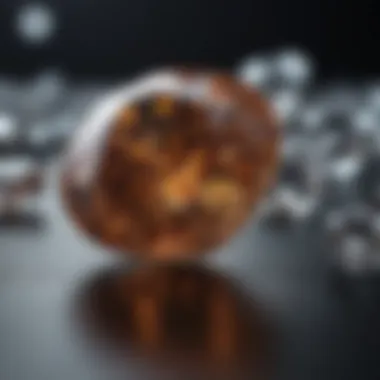
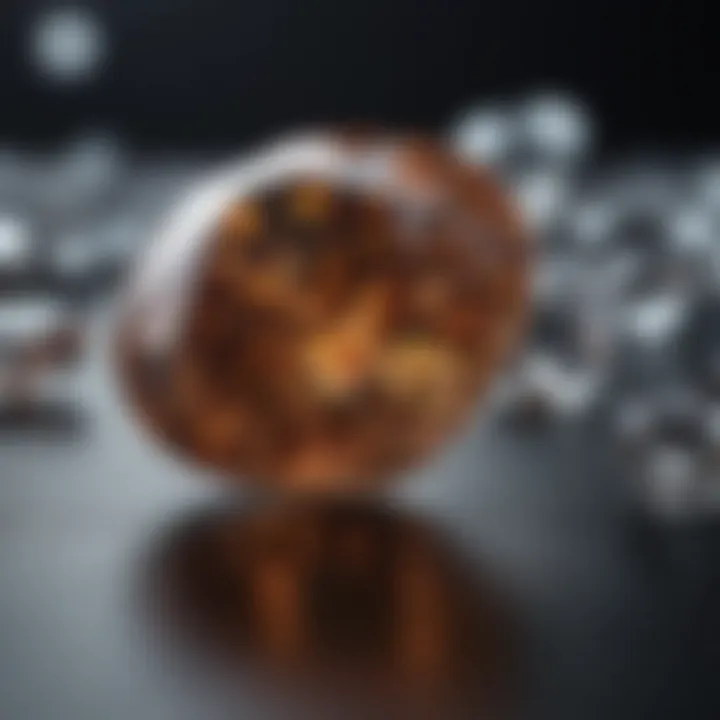
The intersection of luxury and ethics is often fraught with complexities, positioning ethically sourced diamonds as a desirable option for conscientious collectors and consumers alike.
Fair Trade Practices
Fair trade practices constitute a different approach to diamond sourcing, promoting equitable trade structures and supporting communities involved in gem extraction. Unlike conflict diamonds, fair trade diamonds emphasize sustainability and ensure that workers receive just remuneration for their labor.
Engaging with certified fair trade diamond suppliers means contributing positively to the communities that contribute to the jewelry industry. These operations often prioritize environmental standards alongside social equity, allowing gemstones to be mined with minimal environmental disruption and fair treatment for laborers.
Here are some benefits of choosing fair trade diamonds:
- Support for Local Communities: Funds generated from fair trade practices often go back into local economies, fostering development.
- Transparency in Sourcing: Buyers can be assured of where their stones come from and the conditions under which they were mined.
- Environmental Responsiveness: Operations tend to implement more sustainable mining practices, reducing environmental harm.
By opting for fair-trade diamonds, consumers not just acquire beautiful gems but also make a statement about their values, promoting a market that respects human dignity and nature.
As diamond enthusiasts and collectors navigate their purchasing journey, balancing beauty with ethics becomes paramount, shaping the future of the industry and setting standards for generations to come.
Buying a One Carat Diamond
Buying a one carat diamond represents a significant financial investment and emotional commitment. In this section, we will delve into the essential elements to consider for such a purchase. This understanding is crucial not just for securing a beautiful gem but also for ensuring that buyers make informed decisions that align with their values and expectations.
When contemplating the purchase of a diamond, one must consider various factors that go beyond just the aesthetic appeal. It’s not merely about how sparkly it looks under the light, but rather, understanding what is behind that sparkle. The importance of correlating the price with quality, origin, and certification cannot be overstated.
Choosing the Right Retailer
Selecting the right retailer can make or break your diamond-buying experience. Often, the retailer you choose can offer guidance on the nuances of diamonds, pricing, and certification. It’s tempting to purchase from the first seller you encounter, especially if it appears to have good deals, but this can be the rocky road in your diamond journey.
- Research Reputable Dealers: Investigate online reviews, seek recommendations from friends, or check forums. Places like Reddit often share experiences about what others have gone through and can provide valuable insights into the best jewelers.
- Visit Physical Stores: While online shopping has its perks, nothing beats seeing the diamond in person. Touch it, examine it, and feel it. Ask questions about the stones—true experts will be happy to share detailed information without hesitation.
- Assess Customer Service: How attentive and knowledgeable is the sales staff? Good retailers will not only sell you a diamond; they’ll educate you about it.
- Check for Certification: Ensure they provide certification from reputable grading institutions such as the GIA (Gemological Institute of America) or AGS (American Gem Society). A diamond’s certification not only proves its authenticity but also verifies its quality.
Verifying Diamond Certification
Certification is the backbone of a diamond purchase. It acts as a hallmark of quality, ensuring that what you’re paying for is legitimate. Many buyers may overlook this aspect, thinking it is a cumbersome add-on, but in reality, it’s the golden ticket to understanding your diamond's value.
- Understanding Grading Reports: Grading reports detail factors such as cut, color, clarity, and carat weight. Familiarize yourself with these terms to avoid being caught off guard.
- Verify the Certification Number: Each certified diamond has a unique number. When obtaining your diamond, ensure that this number matches that on the grading report. This confirms that the certification is indeed for that specific stone.
- Recognize the Trusted Institutions: Stick to well-respected entities like GIA or EGL (European Gemological Laboratory). These institutions maintain rigorous standards and provide objective assessments of your diamond.
"Having the right information about a diamond’s certification not only arms you as a buyer but also ensures you are investing your money wisely."
Culmination
In this article, we've dissected various aspects of diamond pricing, particularly concerning one carat gems. It’s imperative for anyone interested in investing or purchasing to grasp the complexities behind the numbers. Diamonds aren’t just stones; they embody emotional and financial value. Therefore, understanding the average price isn’t merely a matter of numbers—it involves considering quality, ethical sourcing, and market dynamics.
One of the significant takeaways is the influence of certification. Buyers should scrutinize evaluating assessments by reputable organizations like the Gemological Institute of America. Certification acts as a gatekeeper, ensuring that what you pay correlates with the diamond’s actual worth.
Moreover, recognizing the difference in market pricing in various regions can lead to significant savings. For instance, a diamond purchased in a bustling city like New York might come with a hefty mark-up compared to the same quality offered in smaller markets, such as those in less urban settings.
The emotional weight tied to diamonds adds another layer of complexity. When chosen with care, a diamond marks milestones—be it engagements, anniversaries, or achievements. Hence, it’s vital for buyers to focus not just on the monetary aspect but also on the sentimental value intertwined with their choices.
To sum up, understanding the average price of a one carat diamond transcends mere financial metrics. It involves analyzing quality, ethical practices, and market trends that all contribute to what one ultimately pays. Being an informed consumer will lead to wiser decisions, ensuring that both value and sentiment are preserved.
Summary of Key Insights
- Grasping diamond pricing is essential for both investment and sentimental purposes.
- Certification by recognized organizations provides legitimacy and assurance of quality.
- Market location can significantly impact pricing; less urban areas may offer better deals.
- Emotional connections to diamonds amplify their worth beyond mere monetary value.
Future Trends in Diamond Pricing
As we look ahead, several trends may shape the diamond market. Firstly, the increasing awareness surrounding ethical sourcing will likely gain momentum. Buyers are becoming more conscientious regarding conflict-free diamonds, leading to a potential shift in pricing dynamics.
Next, synthetic diamonds may continue to carve out a larger market share. They often come at lower prices compared to their natural counterparts, raising questions about future valuation standards in the gem industry. Many consumers, especially younger generations, are embracing these alternatives, suggesting that the traditional diamond will have to compete more aggressively.
Lastly, technological advancements in online retailing could revolutionize how consumers shop for diamonds. Virtual try-ons and augmented reality could offer buyers an unprecedented level of comfort and clarification before making a purchase, impacting overall sales and market trends.
In sum, as the diamond market evolves, staying informed on these trends will better equip potential buyers to navigate and understand the pricing landscape.



